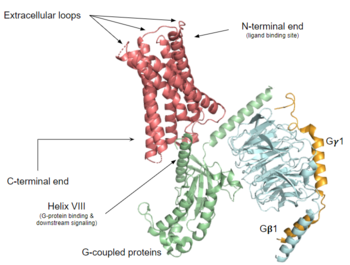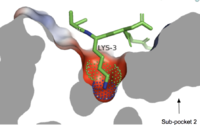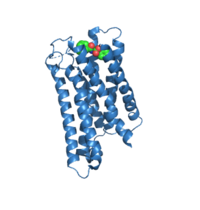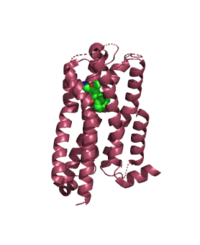Sandbox Reserved 1718
From Proteopedia
Human Itch G-Coupled Protein Receptors
IntroductionG protein-coupled receptors (GPCRs) are the largest class of integral membrane proteins.[1] GPCRs[1][2] are divided into five families; the rhodopsin family (class A), the secretin family (class B), the glutamate family (class C), the frizzled/taste family (class F), and the adhesion family.[1][3] All GPCRs contain a similar seven α-helical transmembrane domain that undergoes a conformation change once bound to its ligand. This conformational change then transduces a signal to a coupled, heterotrimeric G protein which then dictates whether an intracellular signaling pathway will be initiated or inhibited. The initiation of the intracellular signaling pathway occurs in response to a variety of stimuli such as light, Ca2+, peptides, different proteins, and many more stimuli. Ultimately, intracellular signaling accomplishes many interesting physiological roles.[1][3] Human Itch G-coupled protein receptors (GPCRs), or Mast cell-related GPCRs (MRGPRX), have been identified as pruritogenic receptors and are found in human sensory neurons, specifically in the connective tissue mast cells and dorsal root ganglia in humans.[4] They are classified as class A GPCRs, however, MRGPRX receptors respond to a diverse number of agonists, antagonists, and inverse agonists some of which are not typical ligands of class A receptors. MRGPRX are involved in host defense, pseudo-allergic reactions, non-histaminergic itch, periodontitis, neurogenic inflammation, and inflammatory pain.[4] The determination of the first structures of a ligand-activated GPCR was achieved by Robert J. Lefkowitz and Brian K. Kobilka which won them the 2012 Nobel Prize in Chemistry. They also successfully captured images of the first activated GPCR in a complex with a G protein. See Nobel Prizes for 3D Molecular Structure. Related EnzymesAmong Human Itch GPCRs, is a class A GPCR that regulates mast cell degranulation and itch-related hypersensitivity reactions.[5][6] MRGPRX2 is also a target of morphinan alkaloids, like morphine, codeine, and dextromethorphan.[5][6] MRGPRX2 couples to nearly all G-protein families and subtypes with robust coupling to Gq and Gi families.[5][6] is another sub-group of the MRGPRX family, which mediates cholestatic itch and is a target of nateglinide drugs.[5][6] MRGPRX4 also couples to Gq and Gi similar to MRGPRX2. Structure OverviewThe contains 7 transmembrane helices (TM 1-7), 3 intracellular loops (ICL 1-3), and 3 extracellular loops (ECL 1-3).[5] Ligand binding occurs at the N-terminus in the extracellular domain and is composed of two binding sub-pockets.[5] The intracellular domain consists of helix VII and a C-terminal sequence, which binds the G-protein and promotes downstream signaling.[5]
G-proteins and SignalingG-proteins, when paired with a GPCR, assist in signal transduction.[7][8] G-proteins are heterotrimeric GTPases composed of three subunits: . The α subunit acts as the main signal mediator and contains a binding site for GDP or GTP, which acts as a biological “switch” to regulate the transmission of a signal from the activated receptor.[7][8] The α subunit will dissociate and can then move in the plane of the membrane from the receptor to bind to downstream effectors to continue signal transmission and ultimately produce a cellular response.[7][8] Gq and Gi Family α SubunitsThe actions that G-proteins induce can be classified based on the sequence homology of α subunit (Gα) present.[7][9] The most well-known are referred to as Gi, Gs, and Gq. The Gs and Gq proteins are stimulatory, while the Gi protein is inhibitory.[7][9] In addition, proteins are classified based on the signaling pathway that they regulate. For example, Gq proteins are seen in a signaling pathway that relies on phospholipase C enzymes, while Gs and Gi proteins are regulators of adenylate cyclase.[9] On this page, we will be focusing solely on the structures of the Gq and Gi proteins and their interactions with mast-cell receptors. Gαq and Gαi are proteins comprised of 359 amino acid residues, with varying sequences, that both contain a helical domain and a GTPase binding domain.[9] The GTPase binding domain is responsible for the hydrolysis of GTP as well as the binding of the β and γ subunits that form the trimeric protein structure. The helical domain contains six α helices, which are responsible for the binding of the G-protein to the coupled receptor.[9] The conformations of the G-proteins vary based on their association with a particular membrane receptor due to interactions between the amino acids in the N-terminus of the α subunit and the C-terminus of the receptor.[9] Ligand Binding Sitepreface
Sub-pocket 1Sub-pocket 1 is formed by TM3, TM6, and ECL2.[5] This sub-pocket is both small and deep which results in the binding of only a single amino acid residue, namely arginine or sometimes lysine.[5] The binding is mediated by two key residues on the MRGPRX2 protein within the binding site: Glu164 and Asp184.[5] The strong charge interactions of these two residues create a highly negatively charged electrostatic interaction within this sub-pocket.[5] Sub-pocket 2Sub pocket 2 is formed by TM1, TM2, TM6, and TM7.[5] This binding sub-pocket is much more shallow and allows for the binding of larger structures.[5] The key residues involved are Trp243 and Phe170 which allow for binding through hydrophobic interactions.[5] The hydrophobicity of this binding pocket accounts for the large electrostatic difference observed between the two sub pockets. Differences To Most Class A GPCRsThe unique characteristics of in comparison to class A GPCRs provides an explanation for the differences in ligand interactions. These differences in intermolecular interactions and structural motifs contribute to the surface level ligand binding in MRGPRX2, whereas the typical ligand interaction occurs deep within the helices in class A GPCRs Toggle SwitchThe toggle switch of class A GPCRs enables the receptor to initiate the signaling cascade. However, MRGPRX2 does not contain the conserved Trp. Instead, it is replaced by Gly.[5] Therefore, the main residues of this motif in MRGPRX2 are Gly236, Tyr113, Phe239, and Trp243.[5] As a result, TM6 is shifted closer to TM3 on the extracellular side of the membrane. This conformational change may account for the lack of ligand binding of MRGPRX2 as compared to family A receptors.[5] This toggle switch swap also means that ligands, such as (R)-zinc-3573 and Cortistatin-14, bind in a different spot than ligands do on other class A GPCRs. In MRGPRX2, Gly236 is located closer to the bottom of the interface, which is the same in MRGPRX4 (Gly229). Compared with other structures, such as 5-HT2AR, A2AR, and β2AR, the TM6 helices of MRGPRX2 and MRGPRX4 are closer to the TM3 helix which makes the binding pocket more occluded than seen in canonical structures.[5] PIF/LLF motifThe MRGPRX2 structure does not contain the conserved at the TM3-TM6 interface.[5] Canonically, the PIF motif consists of a Pro, Ile, and Phe which transduce the signal produce by ligand binding through the TMD within conserved distances (5.50Å, 3.40Å, and 6.44Å respectively).[5][10] In this motif, the residues are not conserved at specific positions in the amino acid sequence but instead are conserved at distances that allow them to interact.[5] In MRGPRX2, the residues that make up TM5 have shifted down two residues making Leu194 analogous to the position of the Pro in other GPCRs. However, in MRGPRX2, Leu194 is slightly closer to the other residues in the motif at 5.48Å.[5] The residue at a distance of 5.50Å in MRGPRX2 is Met196. It does not interact with the motif because it is angled away from the TM3 and TM6 interface.[5] Leu194 interacts with two other residues, Leu117 and Phe232. The additional change from Ileto Leu is why the motif in MRGPRX2 is called the LLF motif.[5] Compared with other structures, such as 5-HT2AR, A2AR, and β2AR, the TM6 helices of MRGPRX2 are closer to the TM3 helix due to the shift in residues which makes the binding pocket more occluded than seen in canonical structures.[5] DRY/ERC motifA (residues 130-132) is present in all GPCRs, while the majority of class A GPCRs have a conserved E/DRY motif. However, MRGPRX2 contains an , which replaces Tyr with Cys.[5] This replacement alters the spatial organization of the helices due to the fact that Tyr is no longer present to push the helices outward.[5] As a result, the binding site in MRGPRX2 is shallower which lead to surface-level ligand interactions.[5] Disulfide bondsIn general, class A GPCRs have a conserved disulfide bond between TM3 and ECL2.[5] In contrast, the is located between Cys168 of TM4 and Cys180 of TM5, which structurally flips ECL2 to the top of TM4 and TM5.[5] This creates the wide ligand-binding surface of MRGPRX2 that contributes to surface level binding which allows diverse ligand interactions.[5] Sodium binding siteThe of MRGPRX2 contains the conserved Asp75, however, the conserved Ser116 on TM3 seen in the sodium binding site of class A GPCRs is replaced by Gly116.[5] The presence of Gly as opposed to the polar Ser contributes to a lack of polar character in addition to decreasing the size of the binding pocket. The binding site generally serves as an allosteric binding site for sodium. Both factors thereby limit the binding of sodium ions to the sodium binding site in MRGPRX2. MechanismBinding to the extracellular N-terminus domain triggers a transmembrane conformation change of , which demonstrates a less significant change when compared to other class A GPCRs due to the surface level binding of the ligand to MRGPRX2.[5] Once ligand binding and the conformational change to the active state have taken place, the signal is relayed to the α-subunit of the heterotrimeric G-protein.[8] The α-subunit will then exchange a GDP for GTP to initiate the dissociation of the α, β, and γ subunits.[8] During this dissociation, the α-subunit is able to travel away from the receptor in the plane of the membrane to bind to downstream effectors to produce a cellular response.[8] Ligand interactions
Clinical Relevanceinitiates IgE-mediated anaphylactic reactions.[13] MRGPRX2-mediated anaphylactic responses occur more quickly than IgE-mediated responses, but the responses also tended to be more transient.[13] Common commercial drugs, like icatibant and cetrorelix, as well as neuromuscular blocking agents activate mast cells through the MRGPRX2 pathway. Many mutations also affect the actions of MRGPRX2. For example, a single residue mutation in sub-pocket 1 (Glu164Arg) prevented interactions between the receptor and ligands like C48/80.[13] In addition, single nucleotide polymorphisms (SNPs) have been linked to many variations of MRGPRX2 which predispose patients to hyperactivation of the receptors. Two of the most common SNPs are Asn62Thr which affects the cytoplasmic domain and Asn16His which affects the extracellular domain.[13] These mutations have been theorized to potentially protect patients from drug-induced mast cell degranulation and hypersensitivity reactions. Interestingly, within the MRGPRX2-mediated pathway, reaction frequencies differ. In the same patients, anaphylactic reactions can occur by both IgE-mediated and MRGPRX2-mediated pathways. The presence of both mechanisms within a patient may be responsible for cross-reactivity between drugs.[13] This has led to a hypothesis that certain drugs may interact with MRGPRX2 on different active sites within the receptor. In addition, studies have also led to hypotheses that the intracellular signaling pathways triggered by the binding of varying drugs may have different intracellular responses based on the site of binding. See Also
References
| ||||||||||||
Student contributors
Madeline Beck Joey Gareis




